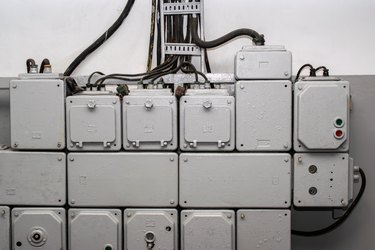
A double pole double throw, or DPDT, relay is an electrical relay that is used to control four circuits. It has two inputs and each input has two outputs, for a total of four outputs. It has many potential uses, such as changing the direction a motor will turn.
Types of Relays
Video of the Day
All electrical relays have one thing in common—they control things where it is inconvenient or impossible for a person to flip a switch. For example, electrical relays are used to turn on the motor to open an automatic garage door, as well as to turn on a furnace.
Video of the Day
Many modern relays are "solid-state," meaning they use transistor-like devices to do their work. Electromechanical relays, however, are still in use, and the working parts are easy to see and understand. They include an electromagnet, which is turned on by a low-voltage control circuit, and a contact switch, which in turn controls the load circuit. When the electromagnet is energized, it behaves just like someone flipping a light switch, by pulling the switch up or down.
Single Pole Relays
A simple electrical circuit requires two wires. Break one wire leading to a lamp, and it goes out. That is exactly what most household switches do. Called a single-pole switch, it opens one wire in the circuit. Because it only turns the light on or off, it is also called single throw. This type of switch is labeled SPST.
For a "three-way" circuit, however, a different kind of switch is required; it is never off, it just routes one side of the circuit over one of two wires. If both switches are set on the same wire, the lamp goes on. If they are set on different wires, the lamp goes off. This kind of switch is a single-pole, double-throw (because it has two "on" positions), or SPDT.
Double Pole Relays
The main circuit breaker in any building is another type of switch. It positively disconnects all of the power to the building, so it breaks both sides of the circuit. This is a double pole switch, and because it is only on or off, it is a single throw, so it is a DPST switch.
The DPDT relay is the fourth kind of simple switch. The "DP" means that it is a double pole, so it switches both sides of the circuit, and the "DT" means that rather than just turning on and off, it switches from one set of wires to another.
One Final DPDT Relay Variable
A household wall switch will stay the way you leave it. Turn on the lights, and it stays on; turn it off and it stays off. A relay, however, behaves in a different way. Since it is operated by an electromagnet, when the magnet is de-energized, the switch will go back to its original position.
For a DPDT relay, that means that when the control circuit is off, the relay will turn on either circuit A or circuit B. It is the user's choice, but it must be determined before the relay is installed.